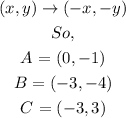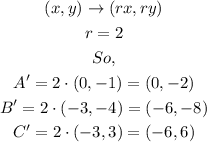Given the triangle ABC :
The coordinates of the triangle are :

First, translation a long the vector (-1 , -3)
So, the rule of translation will be :

Second, Rotation 180 degree about the origin:
The rule of rotation will be :

Finally, dilated with a factor of 2:
So, the rule will be :
